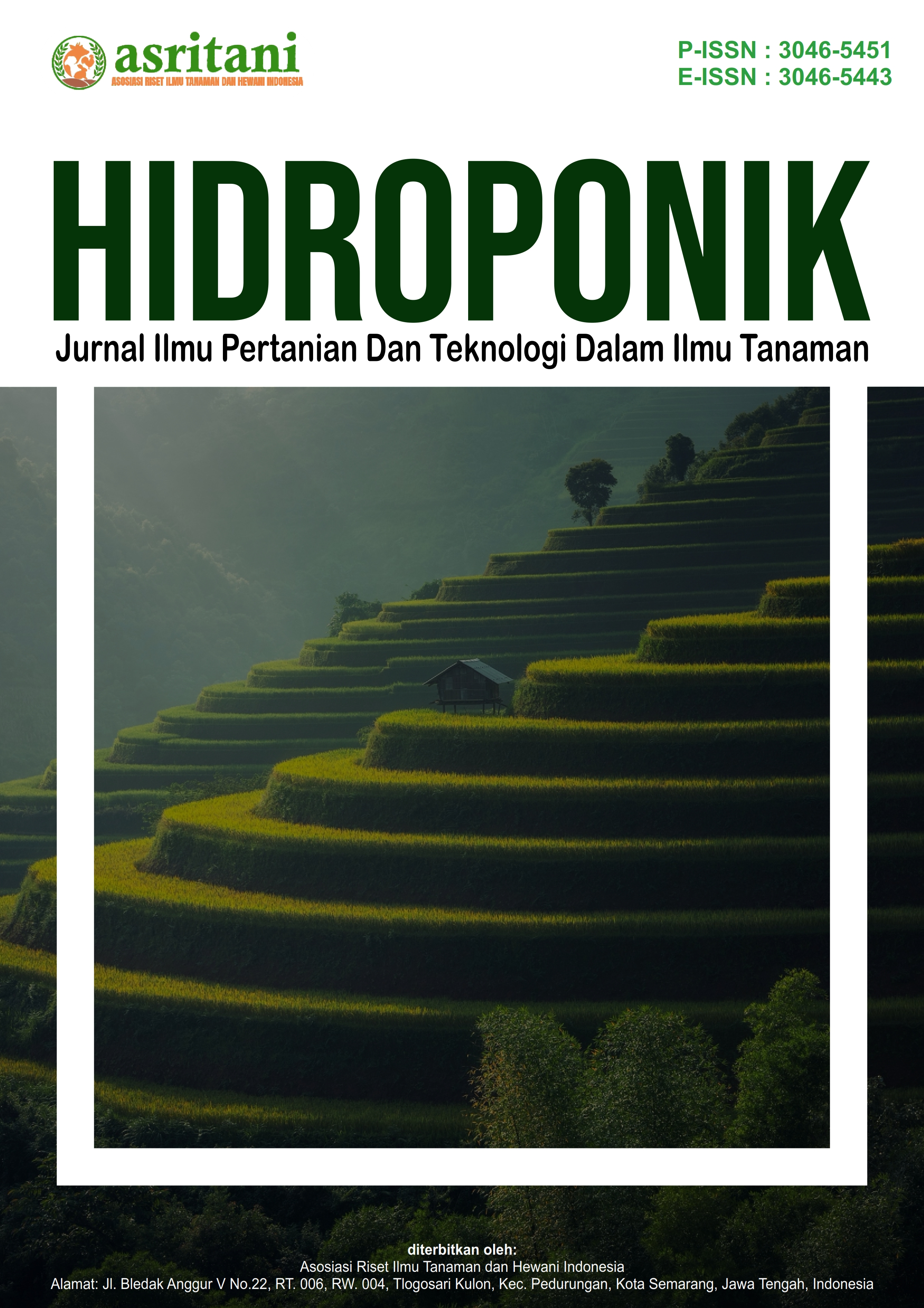Studi Etnobotani Tanaman Mustajab (Abelmoschus manihot) sebagai Antipiretik Alami Berdasarkan Pengetahuan Tradisional Masyarakat RW 08, Desa Sindangsari, Garut
DOI:
https://doi.org/10.62951/hidroponik.v2i1.221Keywords:
Ethnobotany, Garut, Medical, Mustajab plantAbstract
Garut is one of the areas that has local cultural wisdom that is still beautiful and preserved. The diversity of existing plants has sufficient economic value and has potential as alternative ingredients and medicines. The people of Garut still cultivate and use plants as alternative medicines that can cure various diseases. The Mustajab plant or Gedi Leaf with the scientific name Abelmoschus manihot of the Malvace family is one of the herbal plants that has long been used by the people of Sindangsari village as a fever reducer or pyretic in babies. Pyretics is a condition in which the body experiences an increase in temperature above normal limits due to a response to infection or inflammation. This research was conducted in Sindangsari Village, Leuwigoong District, Garut Regency. The method used in this research is an exploratory survey method. The data collection technique uses a purposive sampling method. This research data analysis uses qualitative and quantitative methods. To calculate the use value, the UV method is used. Apart from that, the Fidelity Level Index (FLI) method is also used. Mustajab leaves are included in the category of plants with metabolite compounds which can produce compounds from the soil itself. Mustajab leaves can cure fever in babies because they contain many active compounds, one of which is flavonoid compounds. Based on the results presented in the table, it can be seen that the highest FL value is in the mustajab plant which is used as a treatment for fever in babies with a FL value of 51.5%. Based on the results table, it can be seen that the highest UV value is in the use of mustajab leaves as a medicine for baby fever with a UV value of 0.51. There are many processing and application methods for using mustajab leaves as traditional medicine, including boiling, squeezing and pounding. Based on the data above, it can be concluded that mustajab leaves are one of the traditional food plants which are usually used by rural communities as an alternative medicine to reduce fever in babies.
References
Caunca, E. S., & Balinado, L. O. (2021). Determination of use-value, informant consensus factor, and fidelity of medicinal plants used in Cavite, Philippines. Asian Journal of Biological and Life Sciences, 10(2), 443–453.
Dewi, A. P., Peniwidiyanti, P., Hariri, M. R., Hutabarat, P. W. K., Martiansyah, I., Lailaty, I. Q., Munawir, A., Giri, M. S., & Ambarita, E. (2023). Ethnobotany of food, medicinal, construction, and household utilities producing plants in Cikaniki, Gunung Halimun Salak National Park, Indonesia. Journal of Mountain Science, 20(1), 163–181.
Fauziah, H. A., Al Liina, A. S., & Nurmiyati, N. (2017). Studi etnobotani tumbuhan upacara ritual adat kelahiran di Desa Banmati, Kecamatan Tawangsari, Kabupaten Sukoharjo. Jurnal Biologi dan Pendidikan Biologi, 2(2), 24–28.
Ilyas, A. N., Rahmawati, R., & Widiastuti, H. (2020). Uji aktivitas antikolesterol ekstrak etanol daun gedi (Abelmoschus manihot (L.) Medik) secara in vitro. Window of Health: Jurnal Kesehatan, 3(1), 57–64.
Kastiwi, E., Suhendy, H., & Wardani, G. A. (2022). Studi etnobotani tumbuhan sebagai obat antipiretik di masyarakat Desa Sundawenang Kecamatan Salawu Kabupaten Tasikmalaya. Prosiding Seminar Nasional Diseminasi, 2, 365–377.
Kurniati, Y., Hernawati, D., & Putra, R. R. (2023). Etnobotani tanaman pangan di Desa Cigedug Kabupaten Garut. SAINTIFIK: Jurnal Matematika, Sains, dan Pembelajarannya, 8(2), 151–158.
Mamahani, A. F., Simbala, H. E., & Saroyo. (2016). Etnobotani tumbuhan obat masyarakat Subetnis Tonsawang di Kabupaten Minahasa Tenggara Provinsi Sulawesi Utara. PHARMACON: Jurnal Ilmiah Farmasi, 5(2), 205–212.
Muktiningsih, S. R., Muhammad, H. S., Harsana, I. W., Budhi, M., & Panjaitan, P. (2001). Review tanaman obat yang digunakan oleh pengobat tradisional di Sumatera Utara, Sumatera Selatan, Bali, dan Sulawesi Selatan. Media Penelitian dan Pengembangan Kesehatan, 11(4), 150–827.
Rizal, S. (2020). Manfaat alam dan tumbuhan "sumber belajar anak" dalam perspektif Islam. Childhood Education: Jurnal Pendidikan Anak Usia Dini, 1(2), 96–107.
Shanthi, R. V., Jumari, & Izzati, M. (2014). Studi etnobotani pengobatan tradisional untuk perawatan wanita di masyarakat Keraton Surakarta Hadiningrat. BIOSAINTIFIKA: Journal of Biology & Biology Education, 6(2), 85–93.
Suryawati, S., & Wibowo, L. (2019). Pengaruh ekstrak etanol daun mustajam (Archyranthes aspera L.) terhadap penurunan kadar malondialdehid (MDA) tikus putih (Rattus norvegicus) yang mengalami hipertermia. Jurnal Kedokteran Brawijaya, 30(3), 224–230.
Tapundu, A. S., & Anam, S. (2015). Studi etnobotani tumbuhan obat pada suku Seko di Desa Tanah Harapan, Kabupaten Sigi, Sulawesi Tengah. Biocelebes, 9(2), 66–86.
Wulandari, F., & Batoro, J. (2016). Etnobotani jagung (Zea mays L.) pada masyarakat lokal di Desa Pandansari Kecamatan Poncokusumo Kabupaten Malang. Jurnal Biotropika, 4(1), 17–24.
Zenderland, J., Hart, R., Bussmann, R. W., Panjagua Zambrana, N. Y., Sikharulidze, S., Kikvidze, Z., Kikodze, D., Tchelidze, D., Khutsishvili, M., & Batsatsashvili, K. (2019). The use of “use value”: Quantifying importance in ethnobotany. Economic Botany, XX(X), 293–303.
Downloads
Published
How to Cite
Issue
Section
License
Copyright (c) 2025 Hidroponik : Jurnal Ilmu Pertanian Dan Teknologi Dalam Ilmu Tanaman

This work is licensed under a Creative Commons Attribution-ShareAlike 4.0 International License.





